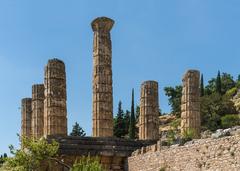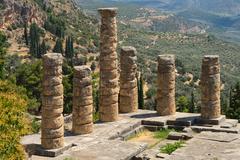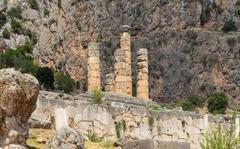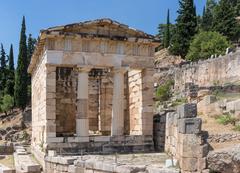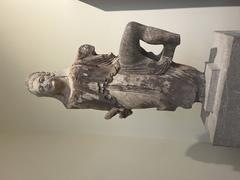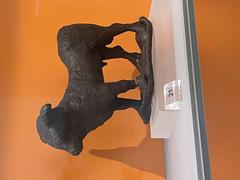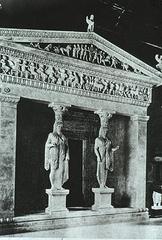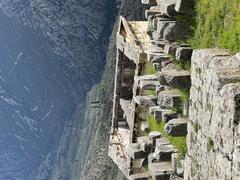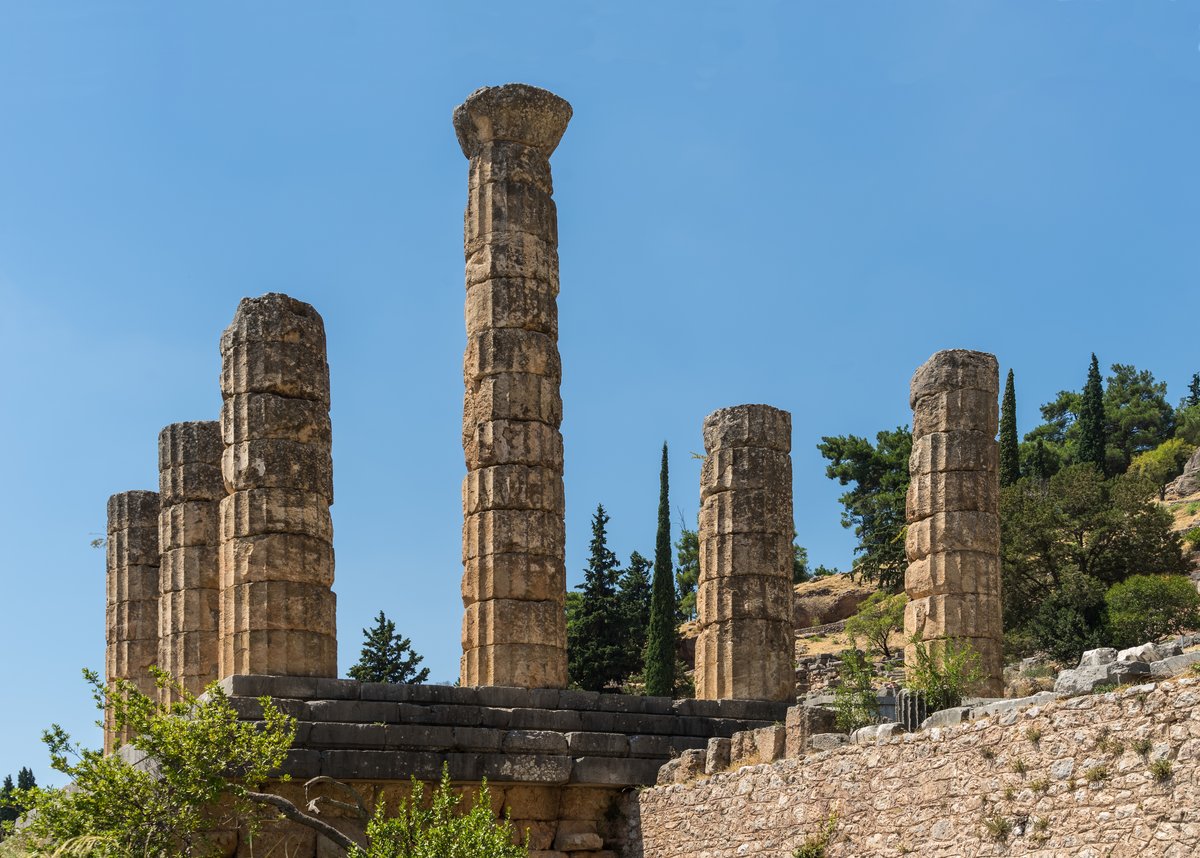
Temple of Apollo Delphi: Visiting Hours, Tickets, and Comprehensive Guide to Delphi Historical Sites
Date: 14/06/2025
Introduction: The Enduring Legacy of Delphi and the Temple of Apollo
Nestled on the sunlit slopes of Mount Parnassus, the Temple of Apollo at Delphi is one of the most revered archaeological sites in Greece. Famed as the “navel of the world” (omphalos) in ancient mythology, Delphi served as the seat of the Oracle, the Pythia, whose enigmatic prophecies guided the fate of individuals and city-states for centuries. Today, Delphi stands as a UNESCO World Heritage Site, drawing visitors with its panoramic vistas, monumental ruins, and profound spiritual history.
Whether you are a history enthusiast, architecture lover, or myth seeker, this in-depth guide covers everything you need to plan your visit: from current visiting hours and ticket prices to accessibility, travel recommendations, and detailed insights into the temple’s mythological foundations, architectural evolution, and cultural impact.
For official updates and further information, consult resources like the Greek Ministry of Culture, the UNESCO World Heritage Site page for Delphi, and the Delphi Archaeological Museum.
Table of Contents
- Introduction: The Enduring Legacy of Delphi and the Temple of Apollo
- Practical Visitor Information
- Historical Overview and Architectural Insights
- Highlights of the Delphi Archaeological Site
- Practical Tips for Your Visit
- Current Visiting Conditions (June 2025)
- Additional Nearby Attractions
- Frequently Asked Questions (FAQ)
- Plan Your Visit: Resources and Final Tips
- References and Further Reading
Practical Visitor Information
Visiting Hours (as of June 2025)
- Summer (April 1 – October 31): 08:00–20:00, except Tuesdays (10:00–17:00). Last admission 20 minutes before closing. Closing times may adjust in September and October due to daylight.
- Winter (November 1 – March 31): 08:30–15:30, with last admission at 15:10.
- Closed on: January 1, March 25, May 1, Easter Sunday, December 25 and 26 (odysseus.culture.gr).
Ticket Prices
- Standard Admission: €20 (includes both the archaeological site and the museum).
- Reduced Admission: 50% discount for EU citizens over 65 (October 1 – May 31, with ID).
- Free Admission: EU citizens under 25, children, and on select days (March 6, April 18, May 18, last weekend of September, October 28, and every first Sunday November–March) (travellingtrekker.com).
- Where to Buy: Purchase onsite or online via the Ministry of Culture and Sports. E-tickets are accepted.
Accessibility
- Terrain: The site is on a hillside with uneven stone paths and steps. Comfortable footwear is essential.
- Mobility Considerations: Some areas are challenging for those with mobility issues, particularly the climb to the stadium. Some paths are partially accessible.
- Facilities: Modern restrooms are available by the museum (none within the site itself). Free parking is nearby, though limited during peak times.
Getting There
- By Car: About 2.5–3 hours northwest of Athens via National Road 48 (thebettervacation.com).
- By Bus: Daily departures from Athens’ Liosion Bus Station.
- Guided Day Trips: Available from Athens, often including the site, museum, and a stop at Arachova (welcome-greece.gr).
Guided Tours and Visitor Tips
- Guided and Audio Tours: Enhance your visit with licensed guides or audio guides available at the entrance.
- Group Tours: Many operators offer day trips from Athens, often including detailed historical insights and convenient transport.
- Best Times: Arrive early or late afternoon to avoid crowds and midday heat.
Facilities and Site Regulations
- No food or drink sales onsite: Bring your own water and snacks.
- Preservation: Do not climb on ruins or touch artifacts.
- Photography: Allowed throughout the site. Drones require special permission.
Historical Overview and Architectural Insights
Mythological Foundations
Delphi was considered the spiritual and geographical center of the ancient Greek world. According to myth, Zeus released two eagles from opposite ends of the earth, which met at Delphi, marking it as the earth’s center. The omphalos stone at the site symbolized this status (Fatelines).
Originally, the sanctuary was dedicated to Gaia, the earth goddess, before Apollo, after slaying the serpent Python, claimed it as his own.
Construction Phases and Design
- 7th Century BCE: The first temple was constructed, reflecting early Archaic design.
- 6th Century BCE: After fire destroyed the original, a grand Doric-style temple was built with pan-Hellenic funding.
- 4th Century BCE: Architect Spintharus rebuilt the temple post-earthquake, with six columns at either end and fifteen along the sides, primarily in local limestone.
- Roman Period: The sanctuary was maintained and embellished under Roman patronage.
The Oracle and Religious Practices
The Pythia, Apollo’s priestess, delivered prophecies from the adyton, a chamber beneath the temple, possibly influenced by natural vapors (Ancient Engineering Marvels). Leaders and citizens alike sought her guidance on matters ranging from war to colonization.
Rituals included processions along the Sacred Way, sacrifices, and offerings deposited in treasuries lining the route (Greek Pathways).
Artistic and Architectural Legacy
The temple is a classic example of Doric architecture, with fluted limestone columns and marble decorative elements. Sculpted pediments depicted Apollo’s arrival and mythic battles, while metopes featured reliefs of legendary events (Take Me To Greece).
The temple’s design—aligned with religious and astronomical principles—influenced architecture across the Greek world, and its art treasures, such as the Charioteer of Delphi, are preserved in the adjacent museum.
Highlights of the Delphi Archaeological Site
The Sacred Way
The processional route to the Temple of Apollo is lined with remnants of treasuries, statues, and monuments donated by Greek city-states, emphasizing Delphi’s pan-Hellenic significance (have-clothes-will-travel.com).
The Temple of Apollo
At the sanctuary’s heart, the reconstructed columns and foundations evoke the temple’s original grandeur. The adyton, where the Pythia sat, is marked on-site, with interpretive panels explaining its ritual significance (wikipedia.org).
Theatre, Stadium, and Surrounding Monuments
- Treasury of the Athenians: Reconstructed in the early 20th century, it originally housed offerings to Apollo.
- Theatre: Built in the 4th century BCE, it offered seating for 5,000 and sweeping valley views.
- Stadium: At the highest point, it hosted the Pythian Games and can be reached by a steep climb (have-clothes-will-travel.com).
- Serpent Column: A replica stands onsite; the original resides in Istanbul.
Delphi Archaeological Museum
The museum displays statues, friezes, and artifacts from the sanctuary, including the renowned Charioteer of Delphi. Admission is included with your site ticket.
Practical Tips for Visiting the Temple of Apollo
Best Times to Visit
- Weather: Visit in spring (April–June) or autumn (September–October) for mild temperatures and fewer crowds (thebettervacation.com).
- Crowds: Mornings and late afternoons are quieter. Off-season visits (November–March) offer tranquility but shorter hours.
Suggested Itinerary
- Site Visit: 1–1.5 hours for the archaeological site; 45–60 minutes for the museum.
- Extended Exploration: Hiking trails on Mount Parnassus are ideal in spring and autumn.
What to Wear and Bring
- Footwear: Sturdy shoes for uneven, sometimes slippery paths.
- Sun Protection: Hat, sunscreen, and water are essential in summer.
- Clothing: Dress in layers to accommodate shifting mountain weather.
Guided Tours and Day Trips
- From Athens: Guided day trips (typically €79–€119) include transport, site and museum tours, and often a stop in Arachova.
- On-site Guides: Licensed guides are available at the entrance.
Current Visiting Conditions (June 2025)
- Site Status: The Temple of Apollo and the broader Delphi site are fully open, with no major restoration restricting access (odysseus.culture.gr).
- Health and Safety: Standard protocols apply; check the official site for any updates.
Additional Nearby Attractions
- Sanctuary of Athena Pronaia: A short walk from the main site, featuring the iconic Tholos.
- Arachova: A mountain village famed for its architecture and cuisine, often included in tours.
Frequently Asked Questions (FAQ)
Q: What are the Temple of Apollo’s visiting hours?
A: 08:00–20:00 in summer (April–October); 08:30–15:30 in winter. Last admission 20 minutes before closing.
Q: How do I buy tickets?
A: Purchase onsite or online through the Ministry of Culture and Sports website.
Q: Is the site accessible for people with mobility issues?
A: The terrain is uneven and steep in places; some paths are partially accessible.
Q: Can I take photos?
A: Yes, throughout the site. Drones require special permission.
Q: Are guided tours available?
A: Licensed guides are available at the entrance. Many day trips from Athens include guided tours.
Plan Your Visit: Resources and Final Tips
Prepare for your journey by downloading the Audiala app for audio guides and interactive maps. For official updates, consult the Greek Ministry of Culture, UNESCO World Heritage Site page for Delphi, and Delphi Archaeological Museum. Explore related articles on Ancient Greek Historical Sites, Travel Tips for Greece, and Athens Day Trips.
Summary
The Temple of Apollo at Delphi is a testament to the enduring interplay of myth, history, art, and spirituality. As the ancient world’s center of prophecy and pan-Hellenic unity, its ruins invite modern visitors to reflect on the ideals of “Know thyself” and to experience the grandeur of Greece’s cultural heritage. With diligent preservation, expert guides, and modern amenities, Delphi remains a must-visit destination for all who seek to connect with the past.
Visuals and Media Recommendations
Enhance your planning with high-quality images of the Temple of Apollo, panoramic views of Mount Parnassus, maps of the archaeological site, and virtual tour links. Use alt text like “Temple of Apollo at Delphi ruins” and “Map of Delphi archaeological site” for accessibility and SEO.
References and Further Reading
- Discover the Temple of Apollo at Delphi: History, Tickets, Hours & Travel Tips, 2025, (https://www.culture.gr)
- Architectural Features, Site Layout, and Visitor Guide for the Temple of Apollo at Delphi, 2025, (https://www.delphi.gr/)
- Visiting the Temple of Apollo at Delphi: History, Tickets, and Travel Tips, 2025, (https://greek.mythologyworldwide.com)
- Temple of Apollo Visiting Hours, Tickets & Guide to Delphi Historical Sites, 2025, (http://odysseus.culture.gr)
- UNESCO World Heritage Site - Delphi, 2025, (https://whc.unesco.org/en/list/393)
- Delphi Archaeological Museum Information, 2025, (https://www.athensinfoguide.com/museum/delphi.htm)
